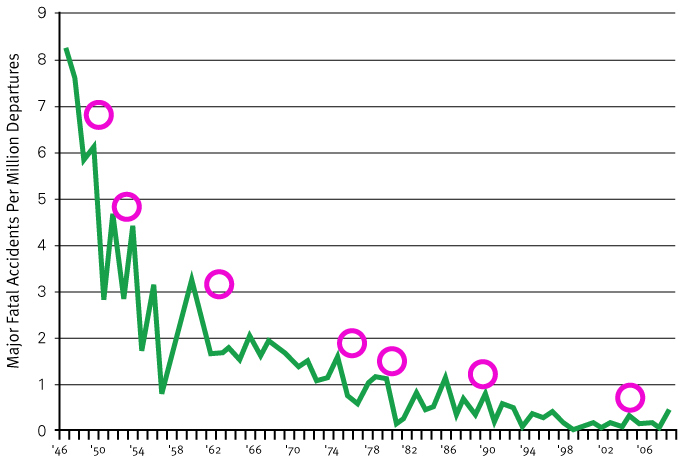Despite a string of fatal accidents during 2003-2009, all involving regionals, FAA officials point out that Americans are in the midst of an extremely safe era for commercial air travel. FAA Administrator Randy Babbitt noted that before the 2009 Continental Flight 3407 crash outside Buffalo, 29 months had gone by without a fatal incident.
Accident rates have plummeted over the decades due in large part to technology improvements. This graph, which includes data from both major airlines and regionals, shows that the rate of incidents involving multiple fatalities in 2008 is a fraction of what it was in 1946. There were more than eight fatal accidents per million departures in 1946; since 1985, the rate has never exceeded one fatal accident per million.
Breakthroughs in Major Accident Rates Since 1946 (Hull Losses or Multiple Fatalities)

Source: FAA, 1946-2008, for all Part 121 operations
However, many aviation observers raise concerns that things are shifting. The training backgrounds of pilots, for example, have changed. Newly hired pilots coming from the military dropped from 90 percent in 1992 to 30 percent in 2008, according to aviation consultant Kit Darby. The majority of pilots now come from civilian training academies or aviation schools.
More importantly, regional airlines now account for more than half of all scheduled domestic flights. Major airlines have outsourced more and more of these flights and under the commercial arrangements between the regionals and majors [read one of these agreements] [PDF], the regionals may operate under a different set of safety standards, different management and really have nothing do with the major airlines in terms of safety and training. Some majors do not take responsibility for their regionals safety and training, instead leaving oversight up to the FAA . However, the NTSB and other safety observers say the FAA bar is set too low when it comes to several safety measures. Many major airlines voluntarily go beyond the bar set by the FAA on safety standards -- some regionals don't.
One way the FAA has looked to improve safety is having the airlines voluntarily self-report safety problems. Under Nick Sabatini, former FAA associate administrator for safety, the FAA moved into such voluntary "partnership programs" in order to go beyond reactive accident-scene investigations to more preventative data-gathering methods.
Sabatini, a New York City police officer before he joined the FAA, likened the partnership programs to former New York City Mayor Rudy Giuliani's program that studied potential precursors of crime such as graffiti. The FAA partnership programs look at early warnings, such as repetitive maintenance problems, that could lead to fatal accidents.
However, after the Continental 3407 crash, the victims' families discovered that many of the regionals, including the one that operated the Continental flight, were not participating in all the voluntary partnership programs.
[Read here Colgan Air's reaction to this FRONTLINE report.]
The families began lobbying Congress to make two key programs mandatory:
The Aviation Safety Action Program [ASAP] encourages employees of air carriers to voluntarily report safety issues. Safety violations reported under ASAP are subject to lesser penalties for the air carrier -- a practice called enforcement-related incentives.
Flight Operations Quality Assurance [FOQA] is another voluntary program where carriers place airborne data-recording systems onboard aircraft. The recording data is removed at regular intervals and is rendered anonymous. The data is then aggregated by the FAA, which uses it to identify dangerous trends that it sees taking place on the ground and in the air. The FAA can use the data to suggest potential remedies without passing the blame to any individual flight crew.
Prior to the accident, Colgan Air did not have FOQA, but has since announced it would implement it. FAA Administrator Randy Babbitt has asked all airlines to implement these programs voluntarily. Legislation moving through Congress would make them mandatory.
In the end, adoption of these safety programs is really just one measure of a carrier’s commitment to improving safety. Ultimately, it is up to the airlines to ensure that the programs are fully implemented and it is up to the FAA to ensure that the data collected is effectively utilized. To date, that has not happened. In a May 2009 audit, the Department of Transportation inspector general found numerous problems with the ASAP program, stating that "ASAP, as currently implemented, is a missed opportunity for FAA to enhance the national margin of safety."